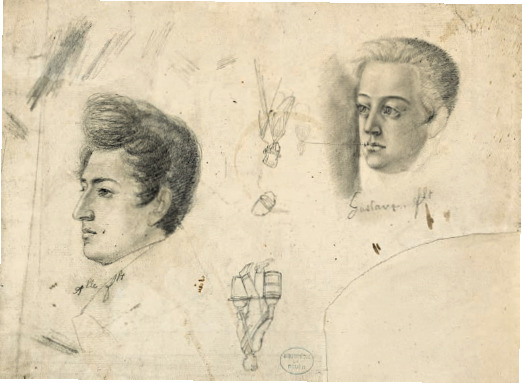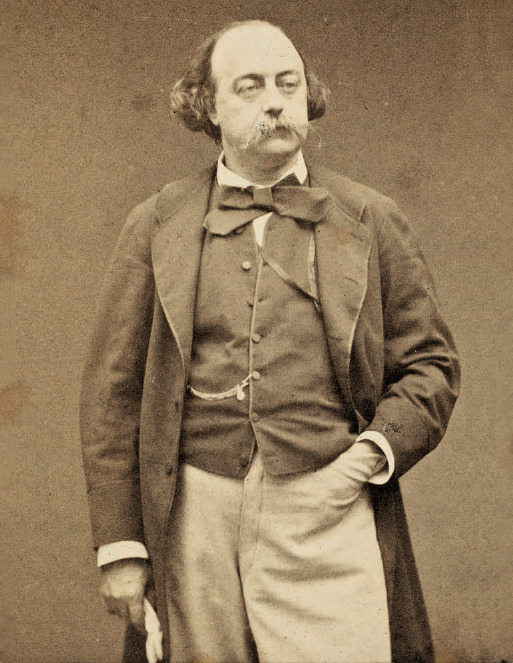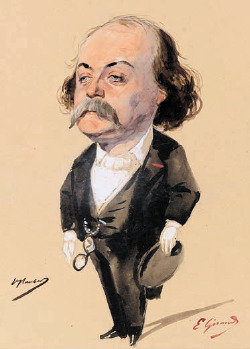
1857 was an important year in the literary life of Gustave Flaubert. His first novel Madame Bovary was published by the publisher Michel Lévy. However, it does not have the success he hoped for. Instead, it is worth a trial for offending morality and the press itself is unleashed against the book. It is a sensational scandal and not an easy experience. Fortunately, Flaubert enjoys the support of famous writers such as Charles Baudelaire, Victor Hugo, Lecomte de L’Isle, Théophile Gautier. In the same year, the writer made a trip to Tunisia (he had already made a trip to the East in 1848, from Egypt to Tripoli and Jerusalem with his friend Maxime Du Camp).
On his return, he decides not to deal with contemporary topics anymore and he starts writing a new novel that takes place in Carthage during the period of the revolt of the mercenaries during the first Punic war. The heroine is called Salammbô, daughter of Amilcare Barca. The mercenary leader, Mâtho, falls in love with her. Flaubert studied the story (reading Appiano, Xenophon, Plutarch and so on) and the archaeological documents in order to make his story, partly imaginary, credible. Salammbô’s mission is to recover the sacred veil stolen by the rebels. Flaubert uses these events as an opportunity to stage violence and sensuality. The book came out in June 1862 and met with immediate success despite the criticisms of Sainte-Beuve.
The Musée des Beaux-arts of Rouen, to celebrate the anniversary of the birth of “l’enfant du pays”, has decided to dedicate a major exhibition to his literary creation through the figure of Salammbô. The exhibition will last until September 21 before being presented at MUCEM in Marseille and elsewhere. The event is not anecdotal. The curators have decided to dedicate a complete section to the genesis of the novels, with the presentation of numerous manuscripts and letters from the author, giving an accurate view of what Carthage was at that time. It is thus possible to better understand the enterprise narrated by Flaubert thanks to all the archaeological material to which reference is made, obviously more complete than what the cryptic writer was able to know. All of this is also interesting to understand how a nineteenth-century historical novel can be conceived.
However, the most important section is dedicated to art. The first work inspired by the book appeared at the Paris Salon in 1869. It is a bronze sculpture by Prosper d’Epinay, Hannibal’s Childhood, which derives directly from the chapter entitled “Hamilcar Barca”. In 1875, a certain Giovanni, a Ukrainian painter who was a pupil of Cabanel, exhibited another work related to the novel, a painting entitled The Serpent. People like the topic, which is used numerous times, for example in 1883 by Claude Bourgonnier. In 1895, sculptor Théodore Rivière made several versions of his Salammbô da Mâtho (a lost waxwork) for the Salon. Among the artists who choose this theme there is also Georges-Antoine Rochegrosse. Moreover, people from abroad liked the novel and Franz von Stuck painted a splendid picture in 1899, Die Sünde. Victoir Prouvé also dealt with the subject as early as 1881 and drew illustrations and a binding in 1893.

Salammbô‘s fashion continued until the early twentieth century. Numerous illustrated editions come out, with works by Rochegrosse, Pierre Vidal, Victor-Armand Poinson, Suzanne-Raphaëlle Lagneau (in 1928) Alméry Lobel-Riche, Eugène Champollion, Robert de Montesquiou (in 1920), François-Louis Smied (in 1923) and many others. Even if Gustave Flaubert’s character has had a long history in art, no leading artist has been tempted to deal with him, apart from Alfons Mucha, who created Incanto and Salammbô in 1897.
Even the world of music has allowed itself to be attracted by this almost mythical figure: Erik Satie with his Trois gymnopédies (1888) and Modest Mussorgsky (early 1930s) are among the composers who loved this tragedy. The exhibition also reveals cinematographic transpositions of the novel, the director Domenico Gaido began in 1914. But, among these there is no masterpiece.
It is rare to visit such a rich and extensive exhibition that it can interest the specialist as well as those who discover Flaubert’s work for the first time. Even the catalog, published by the Gallimard editions of Paris, is a marvel, with the same criteria of clarity and the desire to develop all aspects of this great theme, now also studied in high school. It is also part of the event because it informs us about all the aspects covered in this vast investigation into the Norman writer’s masterpiece.
Un omaggio a cento anni dalla nascita
Il 1857 è stato un anno importante nella vita letteraria di Gustave Flaubert: esce Madame Bovary, il suo primo romanzo presso l’editore Michel Lévy. Ma non ha il successo che sperava, gli vale infatti un processo per offesa al buon costume e la stessa stampa si scatena contro il libro. É uno scandalo clamoroso e un’esperienza non facile. Per fortuna, gode dell’appoggio di scrittori celebri come Charles Baudelaire, Victor Hugo, Lecomte de L’Isle, Théophile Gautier. Nello stesso anno lo scrittore compie un viaggio in Tunisia (aveva già fatto nel 1848 un viaggio in Oriente, dall’Egitto a Tripoli e a Gerusalemme con il suo amico Maxime Du Camp).
Decide al suo ritorno di non trattare più un argomento contemporaneo e si mette a scrivere un nuovo romanzo che si svolge a Cartagine nel periodo della rivolta dei mercenari durante la prima guerra punica. L’eroina si chiama Salammbô, figlia di Amilcare Barca. Il capo dei mercenari, Mâtho, si è innamorato di lei. Flaubert ha studiato la vicenda (leggendo Appiano, Senofonte, Plutarco e così via) e anche i documenti archeologici per rendere la sua storia, in parte immaginaria, credibile. Salammbô ha per missione quella di recuperare il velo sacro rubato dai ribelli. Per Flaubert, questi eventi costituiscono un’occasione per mettere in scena violenze e sensualità. Il libro esce nel giugno 1862 e conosce un successo immediato malgrado le critiche di Sainte-Beuve.
Il Musée des Beaux-arts di Rouen, per celebrare l’anniversario della nascita de “l’enfant du pays”, ha deciso di dedicare una grande mostra alla sua creazione letteraria attraverso la figura di Salammbô che durerà fino al 21 settembre prima di essere presentata al MUCEM di Marsiglia e in altri luoghi. L’evento non è aneddotico. I curatori hanno deciso di dedicare una sezione completa alla genesi dei romanzi, con la presentazione di numerosi manoscritti e lettere dell’autore, dando inoltre una visione accurata di cos’era Cartagine a quell’epoca. È così possibile comprendere meglio l’impresa narrata da Flaubert grazie a tutto il materiale archeologico a cui si fa riferimento, ovviamente più completo di quello che ha potuto conoscere il criptico scrittore. Il tutto è anche interessante per capire come si può concepire un romanzo di carattere storico nell’Ottocento.

Ma la sezione più importante è dedicata all’arte. La prima opera ispirata al libro è apparsa al Salon di Parigi nel 1869. Si tratta d’una scultura in bronzo di Prosper d’Epinay, L’infanzia di Annibale, che deriva direttamente dal capitolo intitolato «Hamilcar Barca». Nel 1875, un certo Giovanni, pittore ucraino allievo di Cabanel, espone un’altra opera legata al romanzo, un dipinto dal titolo Il serpente. L’argomento piace e viene utilizzato numerose volte; per esempio, nel 1883, da Claude Bourgonnier. Nel 1895, lo scultore Théodore Rivière realizza diverse versioni del suo Salammbô da Mâtho (una cera perduta) per il Salon. Tra gli artisti che scelgono questa tematica vi è anche Georges-Antoine Rochegrosse. Ma il romanzo è piaciuto anche all’estero e Franz von Stuck nel 1899 dipinge uno splendido quadro, Die Sünde. Victoir Prouvé ha anche lui trattato il soggetto già nel 1881 e ha disegnato delle illustrazioni e una rilegatura nel 1893.
La moda di Salammbô si prolunga fino all’inizio del Novecento. Escono numerose edizioni illustrate, con opere di Rochegrosse, Pierre Vidal, Victor-Armand Poinson, Suzanne-Raphaëlle Lagneau (nel 1928) Alméry Lobel-Riche, Eugène Champollion, Robert de Montesquiou (nel 1920), François-Louis Smied (nel 1923) e tanti altri. Se il personaggio di Gustave Flaubert ha avuto una lunga storia nell’arte, nessun artista di primo piano è stato tentato dall’occuparsene, a parte Alfons Mucha, che ha realizzato Incanto e Salammbô nel1897.
Anche il mondo della musica si è lasciato attrarre da questa figura quasi mitica: Erik Satie con i suoi Trois gymnopédies (1888) e Modest Mussorgsky (inizio anni ’30) sono tra i compositori che hanno amato questa tragedia. La mostra rivela anche trasposizioni cinematografiche del romanzo – comincia nel 1914 il regista Domenico Gaido – ma tra queste non vi è nessun capolavoro.
È raro visitare una mostra così ricca e nutrita che può interessare lo specialista come pure chi scopre per la prima volta l’opera di Flaubert. Anche il catalogo, pubblicato dalle edizioni Gallimard di Parigi, è una meraviglia, con gli stessi criteri di chiarezza e il desiderio di sviluppare tutti gli aspetti di questo grande tema, ormai studiato anche al liceo. Fa anch’esso parte dell’evento perché ci informa su tutti gli aspetti trattati in questa vasta inchiesta intorno al capolavoro dello scrittore normanno.







